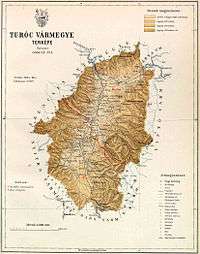Turóc County
| Turóc County Comitatus Thurociensis (Latin) Túróc vármegye (Hungarian) Komitat Turz (German) Turčianska župa (Slovak) | |||||
| County of the Kingdom of Hungary | |||||
| |||||
|
Coat of arms | |||||
 | |||||
| Capital | Turócszentmárton 49°4′N 18°55′E / 49.067°N 18.917°ECoordinates: 49°4′N 18°55′E / 49.067°N 18.917°E | ||||
| History | |||||
| • | Established | 15th century | |||
| • | Treaty of Trianon | June 4, 1920 | |||
| Area | |||||
| • | 1910 | 1,123 km2 (434 sq mi) | |||
| Population | |||||
| • | 1910 | 55,703 | |||
| Density | 49.6 /km2 (128.5 /sq mi) | ||||
| Today part of | Slovakia | ||||
| Martin is the current name of the capital | |||||
Turóc (Hungarian, historically also spelled Túrócz), Slovak: Turiec, Latin: Thurotzium/comitatus Thurociensis, German: Turz) was an administrative county (comitatus) of the Kingdom of Hungary. Its territory is now in north-western Slovakia, where the corresponding Slovak name Turiec is only an informal designation of the corresponding territory.
Geography
Turóc county shared borders with the counties of Nyitra, Trencsén, Árva, Liptó, Zólyom and Bars, situated between the Lesser Fatra (Kis-Fátra) and Greater Fatra (Nagy-Fátra) Mountains. The river Turóc flowed through the county. Its area was 1123 km² around 1910.
Capitals
The capitals of the Turóc county were the Szklabinya Castle and Turócszentmárton (present-day Martin; Slovak name until 1950: Turčiansky Svätý Martin); from 1772 only Turócszentmárton was the capital.
History

Turóc county as a Hungarian comitatus arose before the 15th century. In the aftermath of World War I, the area of the now defunct Turóc county became part of newly formed Czechoslovakia, as recognized by the concerned states in 1920 by the Treaty of Trianon. The territory of the county is now part of Slovakia.

Demographics
1900
In 1900, the county had a population of 51,956 people and was composed of the following linguistic communities:[1]
Total:
- Slovak: 38,233 (73.6%)
- German: 11,039 (21.3%)
- Hungarian: 2,185 (4.2%)
- Croatian: 3 (0.0%)
- Romanian: 1 (0.0%)
- Ruthenian: 0 (0.0%)
- Serbian: 0 (0.0%)
- Other or unknown: 495 (0.9%)
According to the census of 1900, the county was composed of the following religious communities:[2]
Total:
- Lutheran: 27,075 (52.1%)
- Roman Catholic: 22,677 (43.6%)
- Jewish: 2,022 (3.9%)
- Calvinist: 148 (0.3%)
- Greek Catholic: 28 (0.1%)
- Unitarian: 3 (0.0%)
- Greek Orthodox: 0 (0.0%)
- Other or unknown: 3 (0.0%)
1910

In 1910, the county had a population of 55,703 people and was composed of the following linguistic communities:[3]
Total:
- Slovak: 38,432 (68.99%)
- German: 10,993 (19.74%)
- Hungarian: 5,560 (9.98%)
- Ruthenian: 44 (0.08%)
- Romanian: 27 (0.05%)
- Croatian: 4 (0.01%)
- Serbian: 3 (0.01%)
- Other or unknown: 640 (1.15%)
According to the census of 1910, the county was composed of the following religious communities:[4]
Total:
- Lutheran: 27,651 (49.64%)
- Roman Catholic: 25,607 (45.97%)
- Jewish: 1,981 (3.56%)
- Calvinist: 305 (0.55%)
- Greek Catholic: 120 (0.22%)
- Greek Orthodox: 30 (0.05%)
- Unitarian: 8 (0.01%)
- Other or unknown: 1 (0.0%)
Subdivisions
In the early 20th century, the subdivisions of Turiec county were:
- Lower Turóc – its center was Turócszentmárton and the subregion corresponds to the present-day District of Martin
- Upper Turóc – its center was Stubnyafürdő and the subregion corresponds to the present-day District of Turčianske Teplice
| Districts (járás) | |
|---|---|
| District | Capital |
| Stubnyafürdő | Stubnyafürdő, SK Turčianske Teplice |
| Turócszentmárton | Turócszentmárton, SK Martin |
Governors
- Michael Reway de Rewa, comes (fl. 1569).[5]
- Franciscus Revay (fl. 1638).[6]
- Andrea Czeromanka de Tarno.[7]
- Petrus de Reva, comes (fl. 1767).[8]
References
- ↑ "KlimoTheca :: Könyvtár". Kt.lib.pte.hu. Retrieved 2012-06-26.
- ↑ "KlimoTheca :: Könyvtár". Kt.lib.pte.hu. Retrieved 2012-06-26.
- ↑ "KlimoTheca :: Könyvtár". Kt.lib.pte.hu. Retrieved 2012-06-26.
- ↑ "KlimoTheca :: Könyvtár". Kt.lib.pte.hu. Retrieved 2012-06-26.
- ↑ Scriptores Rerum Hungaricarum minores hactenus inediti, synchroni, aut proxime coaevi: 2. Typ. regiae Univers. 1798. pp. 226–.
- ↑ Historia diplomatica de statu religionis evangelicae in Hungaria. 1710. p. 23.
- ↑ Pál Wallaszky (1785). Conspectus reipublicae litterariae in Hungaria ab initiis regni ad nostra usque ad tempora delineatus a Paullo Wallaszky. apud Antonium Loewe, typgraphum et bibliopolam. pp. 258–.
- ↑ Specimen Prævium Diplomaticum Historico-Criticum De Electione Regis Ejusdem: 1. Typis Joannis Thomæ Nobilis De Trattnern. 1767. pp. 260–.

